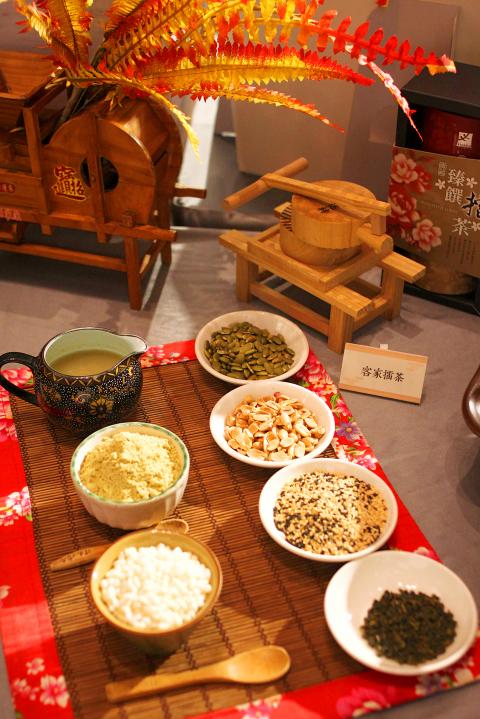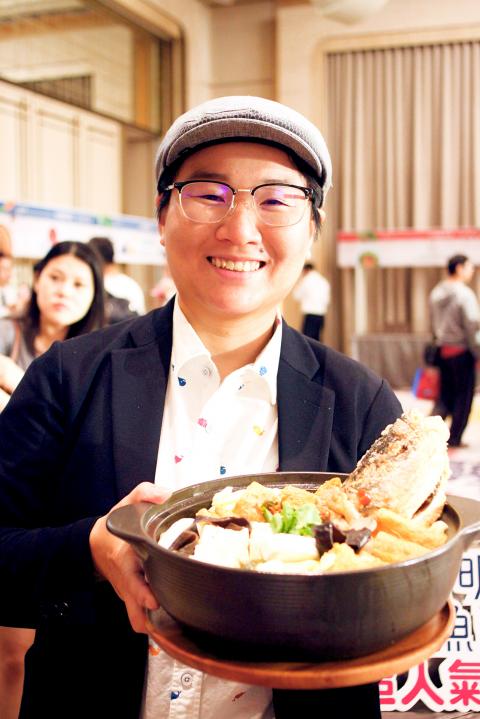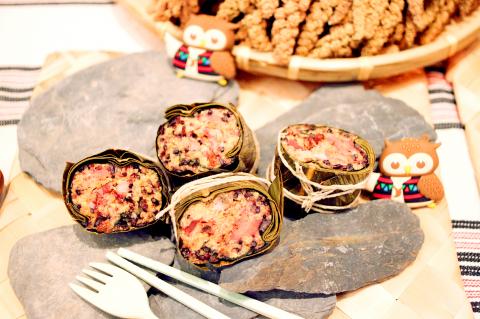After Grace Lin’s (林佳慧) fish head stew appeared on Netflix’s Street Food documentary series earlier this year, her restaurant in Chiayi saw an immediate uptick in tourists.
“If in the past one out of 10 [customers] were from overseas, now it’s three to four out of 10 customers,” Lin said.
The increase was proof of untapped demand for local specialties, as long as customers knew where to find it. After Street Food, Lin opened social media accounts on Facebook and Instagram, where she occasionally posts in English so that overseas customers can find her restaurant, Smart Fish, online.

Photo: Davina Tham, Taipei Times
This weekend only, Taipei-dwellers seeking a taste of the famous fish head stew can head to its pop-up booth at the Taipei World Trade Center, where Smart Fish is among more than a hundred food and beverage vendors showing at the Taiwan Culinary Exhibition. The exhibition opened yesterday and runs until Monday, with admission priced at NT$200.
This year’s exhibition explores Taiwanese culinary heritage from five different angles: local delicacies; old-school eateries; food styling; masterclasses and rare skills; and international cuisines from Japan, Vietnam and the Muslim world.
If there’s one criticism of this exhibition organized by the Taiwan Visitors Association, it’s that despite the growth potential from overseas customers seen by the likes of Lin, this massive business-to-consumer platform continues to reflect a preoccupation with domestic tourism rather than an outward-looking approach.

Photo: Davina Tham, Taipei Times
“Taiwan’s cuisine is a key tourism resource for us to promote our international tourism,” said Chang Hsi-tsung (張錫聰), deputy director-general of the Tourism Bureau, at a pre-event press conference on Thursday. That might explain why Japanese actor, TV chef and heartthrob Mokomichi Hayami was appointed as the face of the trade show.
Yet visitors will be hard-pressed to find any English-language materials about or at the exhibition, and no international media was spotted at the press conference. Given the comprehensive themes and impressive array of vendors gathered from across Taiwan, this is a missed opportunity.
But for gourmands led by their tastebuds and noses, the Taiwan Culinary Exhibition will still be an entertaining and flavorful display of the best of local cuisine.

Photo: Davina Tham, Taipei Times
Thirty-one old-school eateries will serve up foods from longstanding family businesses, including Lim’s fish head stew, rice noodles, lamb hotpot and shaved ice, at a pavilion organized by the Department of Commerce, while a fine wines pavilion by the Ministry of Finance sheds light on local varieties.
Visitors interested in minority cuisines can visit the pavilion of the Hakka Affairs Council introducing different foods eaten during the four seasons of the year, including thunder tea rice (擂茶飯) and an array of sweet or savory glutinous rice cakes. The Council of Indigenous Peoples meanwhile seeks to raise awareness of Aboriginal culture through an introduction to staple ingredients like foxtail millet.
Such ingredients may seem common, said council deputy director Tsai Miao-ling (蔡妙凌), “but these things actually contain our culture and our stories.”

Photo courtesy of Taiwan Visitors Association
Seasonality is a common thread running through many pavilions, with the Tourism Bureau focusing on summertime small-town specialties, including several icy desserts, while the Council of Agriculture showcases fruits and vegetables that reach their peak in these sweltering months.
Even trainspotters have not been left out, with Taiwan High Speed Rail pushing out a limited series of train lunchboxes, or biandang (便當), exclusively for the event.
Food styling forms another arm of the exhibition, as the Ministry of Culture draws on the collections of national museums and heritage institutions to spark a dialogue about traditional craftsmanship and how locally-crafted eating utensils and foods have shaped each other.
The exhibition will also feature masterclass lectures by Le Ruban Patisserie’s head chef Li I-hsi (李依錫), award-winning jam and preserves-maker Ke Ya (柯亞), Taichung cheesemaker Henry Gerard and founder of Taipei’s Mianto vegan restaurant Michel Cason.
Tastings and interactive activities are woven into the exhibition at almost every juncture, but these take fullest expression in a series of demonstrations of sugar art and creative bread-making, as well as hands-on lessons for homemade dishes like dumplings, knife-shaved noodles and stir-fries.

A vaccine to fight dementia? It turns out there may already be one — shots that prevent painful shingles also appear to protect aging brains. A new study found shingles vaccination cut older adults’ risk of developing dementia over the next seven years by 20 percent. The research, published Wednesday in the journal Nature, is part of growing understanding about how many factors influence brain health as we age — and what we can do about it. “It’s a very robust finding,” said lead researcher Pascal Geldsetzer of Stanford University. And “women seem to benefit more,” important as they’re at higher risk of

Eric Finkelstein is a world record junkie. The American’s Guinness World Records include the largest flag mosaic made from table tennis balls, the longest table tennis serve and eating at the most Michelin-starred restaurants in 24 hours in New York. Many would probably share the opinion of Finkelstein’s sister when talking about his records: “You’re a lunatic.” But that’s not stopping him from his next big feat, and this time he is teaming up with his wife, Taiwanese native Jackie Cheng (鄭佳祺): visit and purchase a

Experts say that the devastating earthquake in Myanmar on Friday was likely the strongest to hit the country in decades, with disaster modeling suggesting thousands could be dead. Automatic assessments from the US Geological Survey (USGS) said the shallow 7.7-magnitude quake northwest of the central Myanmar city of Sagaing triggered a red alert for shaking-related fatalities and economic losses. “High casualties and extensive damage are probable and the disaster is likely widespread,” it said, locating the epicentre near the central Myanmar city of Mandalay, home to more than a million people. Myanmar’s ruling junta said on Saturday morning that the number killed had

Mother Nature gives and Mother Nature takes away. When it comes to scenic beauty, Hualien was dealt a winning hand. But one year ago today, a 7.2-magnitude earthquake wrecked the county’s number-one tourist attraction, Taroko Gorge in Taroko National Park. Then, in the second half of last year, two typhoons inflicted further damage and disruption. Not surprisingly, for Hualien’s tourist-focused businesses, the twelve months since the earthquake have been more than dismal. Among those who experienced a precipitous drop in customer count are Sofia Chiu (邱心怡) and Monica Lin (林宸伶), co-founders of Karenko Kitchen, which they describe as a space where they